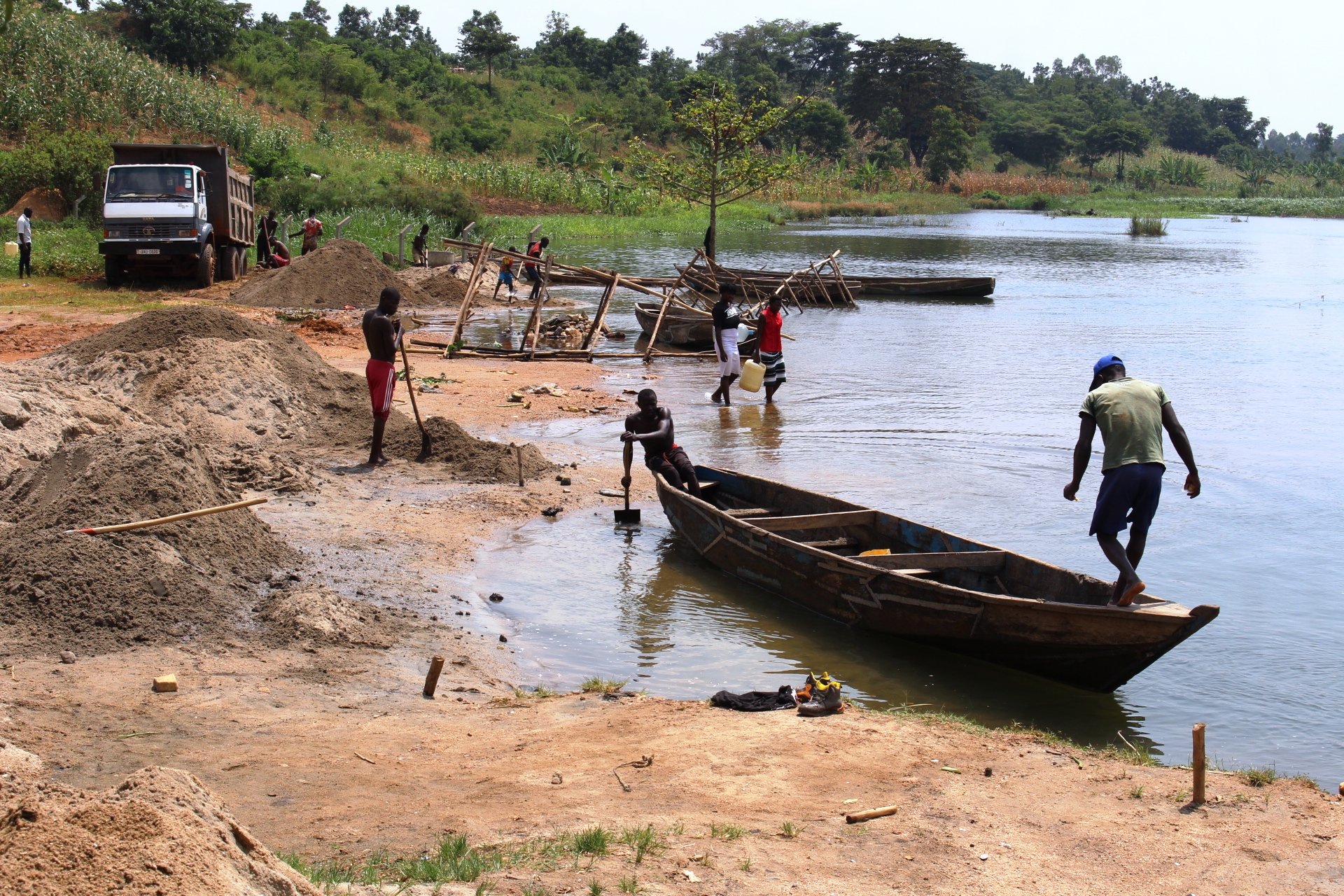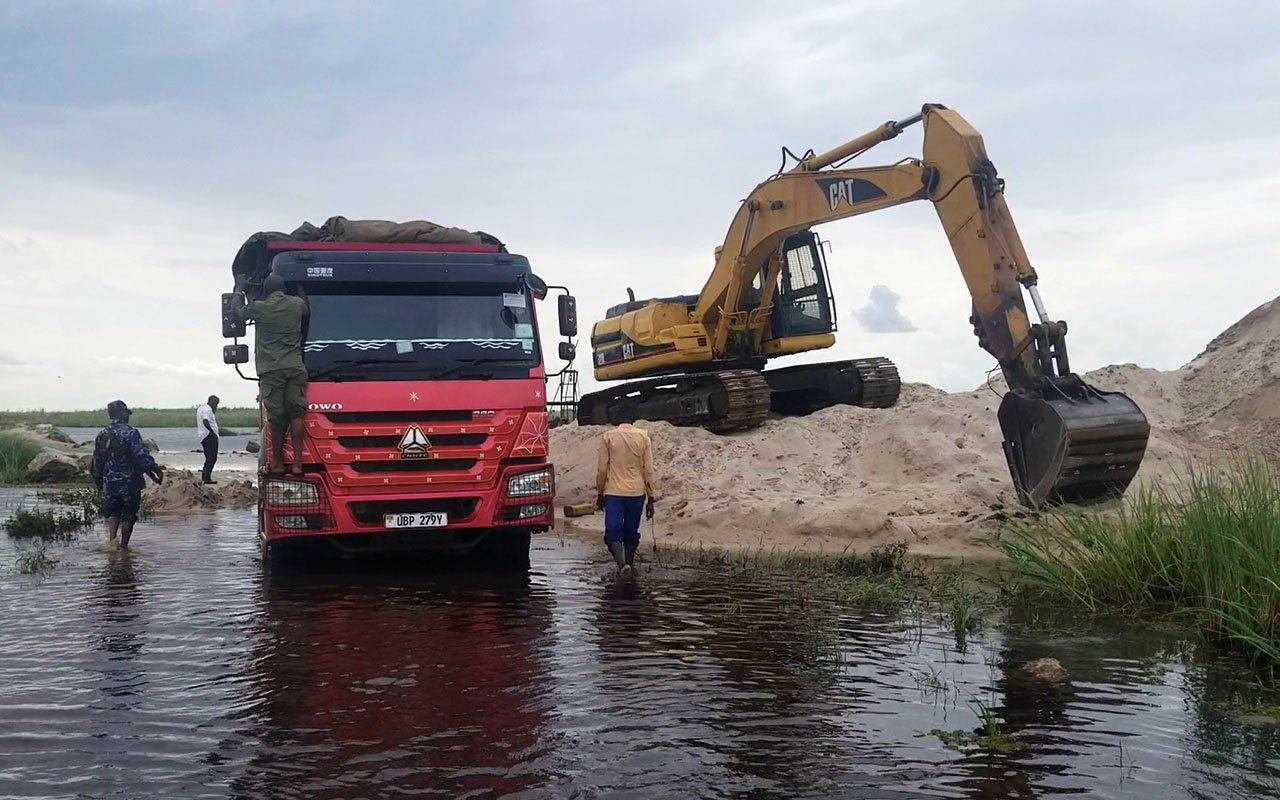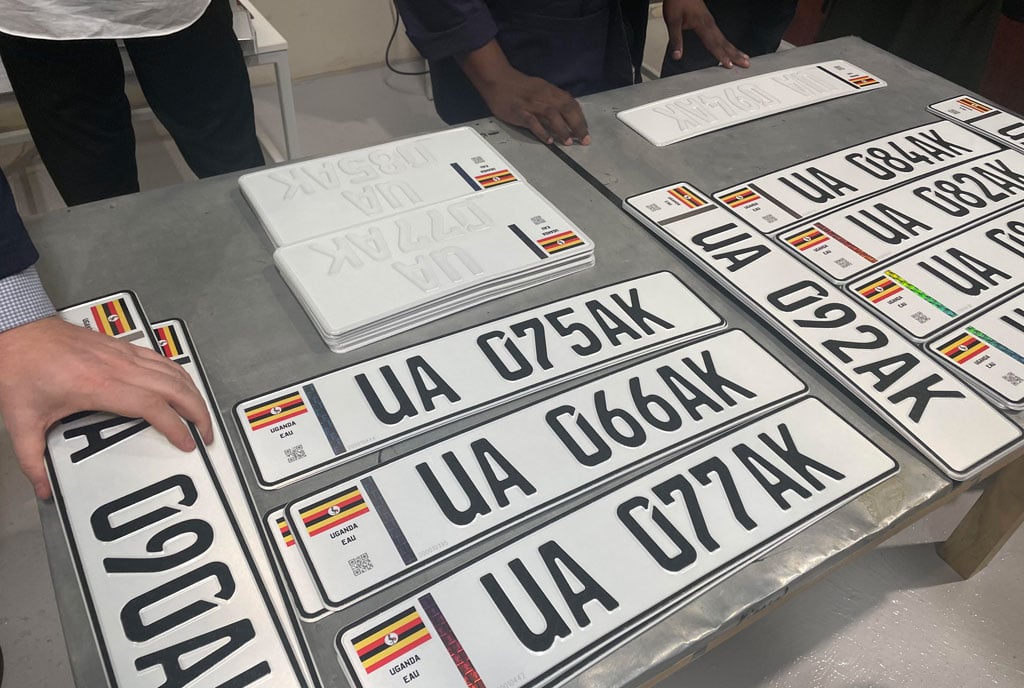Prime
How Kayunga District has failed to curb illegal sand mining

River Nile sand mining at Namusaala in Busaana sub-county, Kayunga District. PHOTOS | FRED MUZAALE
What you need to know:
- In the constant war between conservation and development, sand mining seems to be the new frontier. While the National Environment Management Authority (Nema) has instituted barriers against illegal sand mining in Lwera wetland, other areas such as the banks of the River Nile have been left exposed to the activity as Fred Muzaale writes.
Half-naked, Charles Ngobi rows a canoe from the banks of the River Nile. Sweating under the scorching afternoon sun, he moves towards the middle of the fast-flowing river, about 400 metres downstream of Isimba Hydro Power Dam.
In the rickety boat is a yellow plastic jerry can whose top has been cut off. In the blink of an eye, the 23-year-old dives into the river, the jerry can firmly in his hand. After about four minutes he resurfaces.
The container is full of sand. He pours the contents into the boat. Ngobi dives in and out of the river ten times, until the boat is full, then, he rows back to the riverbank.
Ngobi is among the hundreds of youth engaged in sand extraction on River Nile in Nampanyi village, Busaana sub-county in Kayunga District.

A truck loaded with river sand stuck at Nabuganyi landing site in Kayunga District.
“I have been mining sand in this river for four over years now,” he explains with a smile, adding, “It is a lucrative job because the demand for pure river sand is ever on the rise.”
At Kasana Landing Site alone, at least 60 teenagers are engaged in sand harvesting. Many of them are of primary school-going age. The practice is going on in other sub-counties of the district such as, Kangulumira, Kitimbwa, Kayonza, Nazigo, Galilaaya and Bbaale.
Although the National Environment Management Authority (Nema) banned sand mining in the district because of its effects on the environment, the activity continues to thrive.
From their confessions, the miners are aware that they are engaged in an illegality. None of them has approval from Nema or the Kayunga District Local Government.
“This is our only source of income. Many of us are school dropouts and the government does not have jobs for us. We would have gone into farming but none of us owns a piece of land. The only option is mining sand,” Ngobi says.

Some of the youth who carry out river sand mining at Bugobero village in Kayunga District.
Charles Omara, another sand harvester, explains that although early this year they received a letter from the district authorities directing them to stop the activity, they have deliberately ignored its contents.
“Do they (district authorities) want us to turn to robbery and burglary? Do they want us to break into people’s houses to steal? They should let us do our work in peace because if they try to stop us, it will lead to insecurity in the district,” he says.
Omara argues that instead of harassing them, the government should sensitise them on how best they can mine sand without degrading the riverbed.
The blame games
Immaculate Galimuka, the Busaana sub-county chief, says in January, local leaders convened a meeting with the sand miners and the police, during which the ban on the lucrative activity was communicated to the miners.
“The police are supposed to enforce the ban by arresting the culprits but I am surprised sand mining is still on going. During the meeting, the miners were asked to take advantage of the government poverty alleviation programs such as Emyooga, Parish Development Model (PDM) or better still, find alternative sources of income,” she says.
However, some of the miners claim that they tried to apply for the PDM funds but were not considered, a claim Galimuka dismisses, saying she never received any applications from the group.
Rosette Sikahwa, the Kayunga district police commander says, the police inspected the mining sites and issued warnings to the miners.
“We later carried out an operation during which some sand miners were apprehended. However, they were released after being cautioned. But, since they did not listen to us, we are now going to apply the full force of the law on them,” she says.

A youth carrying sand from a boat at Kasana river Nile banks in Kayunga District.
Sikahwa further explains that whenever the police carry out an operation at the riverbank, the illegal sand miners flee the sites but return after the police leaves. “We cannot maintain a 24-hour presence on the riverbanks so they (miners) take advantage of this to continue engaging in this illegal activity,” she says.
Although the law enforcers claim to be against the illegal activity, the trucks that ferry the sand to Kampala, Jinja, and Mukono districts drive past police roadblocks, without being flagged down.
Well aware that they could be arrested anytime, the miners have now resorted to fleeing into nearby thickets whenever they see a stranger entering their mining territories. Others dive into the river and swim across to Kamuli district, where they take refugee until the operation ends.
Importance of river sand
River sand, the second most exploited natural resource in the world, is preferred by construction companies because it does not require a lot of processing and has better quality than other types of sand.
According to the United Nations Environment Programme (Unep), by 2019, the demand for sand mining for construction materials had tripled in the last two decades, reaching 50 billion tonnes a year.
By 2050, it is projected that up to 68 percent of the world’s population will be living in cities, and to house these people, industrial sand mining and aggregate extraction of sand from riverbeds, lakes, and beaches for use in construction is happening at a faster rate than the materials can be renewed.
David Ochieng, one of the wealthier ‘sand mafias’ says in a day, he harvests three tonnes of sand from the river.
“I employ 20 youths to mine the sand for me everyday. A full Sino truck of sand will earn me Shs500,000, while a small one will earn me Shs150,000,” he says.
However, there are risks, with some miners drowning in the process of scooping sand from the riverbed. Residents say in the space of one year, six miners have drowned in the rush of water caused by the opening of the sluice gates of Isimba dam.
Impact of sand mining on environment
Patrick Musaazi, the Kayunga District senior environment officer, says illegal sand harvesting has greatly degraded the section of the River Nile in his district, resulting in silting and flooding.
“Because of sand mining, some areas in the river that were shallow are now deep. The breeding sites of fish have been tempered with resulting in dwindling stocks. The activity has left the riverbanks bare and exposed to silting. However, it is a complicated scenario, because we can stop the miners but on the other hand, we need sand for construction,” he says.
When the river sediment is washed away due to sand mining, it exposes the surrounding environment to flooding due to the altered natural flow of the river.
Musaazi attributed the increase in sand mining to Nema’s tough stand on sand mining in Lwera wetland which he says has forced miners to resort to River Nile where the authority is yet to enforce the ban.
Is sustainable sand mining possible?
On February 17, 2022, Parliament passed the Mining and Mineral Bills Act 2021 into law. The new law introduced a prohibitive penalty and fines regime, indicating that a person who commits an offence under this law is liable to fines ranging from Shs60 million to Shs500 million or imprisonment terms of between two to seven years, or both.
However, the regulation of sand mining is not part of the Act. The Ministry of Energy and Mineral Resources is seeking to table a Building Substance Bill in Parliament to regulate sand and other mineral materials used in the construction industry.
Until the bill is tabled and passed into law, the only legal framework available is the Nema Act 2019, which prohibits unregulated sand mining in lakes and rivers, recognizing their ecological importance and the need for preservation.
Unemployment
However, local leaders in Kayunga district argue that the law should not be applied given that the population increases and which brings about rampant unemployment.
“Since the sand miners are looking for means of survival, it would be wrong to just push them out of business. Nema should first carry out public awareness and sensitisation on the issue. Secondly, the government should find alternative sources of income for the youth before enforcing the ban on sand mining,” says Saleh Bulinsoli, the speaker of the Kayunga District council.
Experts say regulating of sand mining is the best way to combat the effects of climate change. However, more needs to be done to find alternatives to use in contraction. In the developed world, alternatives like recycled glass waste are being used to substitute sand in concrete.
In its report, Unep outlines recommendations, which if followed will help the world avert a sand crisis and balance the needs of the construction industry with environmental protection. These recommendations include recognizing sand as a strategic resource, regulating the mining process, reducing the use of sand and substituting it with viable alternatives, and restoring ecosystems that have been damaged by sand mining.




